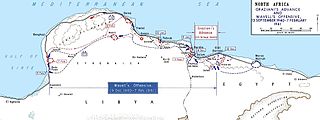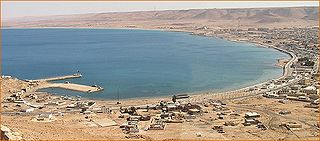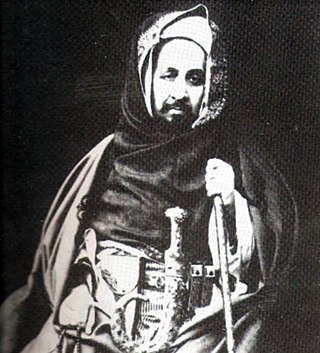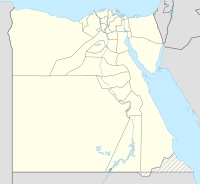
Fort Capuzzo was a fort in the colony of Italian Libya, near the Libya–Egypt border, next to the Italian Frontier Wire. The Litoranea Balbo ran south from Bardia to Fort Capuzzo, 8 mi (13 km) inland, west of Sollum, then east across the Egyptian frontier to the port over the coastal escarpment. The fort was built during the Italian colonial repression of Senussi resistance in the Second Italo-Senussi War (1923–1931), as part of a barrier on the Libya–Egypt and Libya–Sudan borders.

Operation Compass was the first large British military operation of the Western Desert Campaign (1940–1943) during the Second World War. British, Empire and Commonwealth forces attacked Italian forces of the 10th Army in western Egypt and Cyrenaica, the eastern province of Libya, from December 1940 to February 1941.

Operation Sonnenblume was the name given to the dispatch of German and Italian troops to North Africa in February 1941, during the Second World War. The Italian 10th Army had been destroyed by the British, Commonwealth, Empire and Allied Western Desert Force attacks during Operation Compass (9 December 1940 – 9 February 1941). The first units of the new Deutsches Afrikakorps (DAK), commanded by Generalleutnant Erwin Rommel, departed Naples for Africa and arrived on 11 February 1941. On 14 February, advanced units of the 5th Light Afrika Division, Aufklärungsbataillon 3 and Panzerjägerabteilung 39 arrived at the Libyan port of Tripoli and were sent immediately to the front line east of Sirte.

The Western Desert campaign took place in the deserts of Egypt and Libya and was the main theatre in the North African campaign of the Second World War. Military operations began in June 1940 with the Italian declaration of war and the Italian invasion of Egypt from Libya in September. Operation Compass, a five-day raid by the British in December 1940, was so successful that it led to the destruction of the Italian 10th Army over the following two months. Benito Mussolini sought help from Adolf Hitler, who sent a small German force to Tripoli under Directive 22. The Afrika Korps was formally under Italian command, as Italy was the main Axis power in the Mediterranean and North Africa.

The African theatre of the First World War comprises campaigns in North Africa instigated by the German and Ottoman empires, local rebellions against European colonial rule and Allied campaigns against the German colonies of Kamerun, Togoland, German South West Africa, and German East Africa. The campaigns were fought by German Schutztruppe, local resistance movements and forces of the British Empire, France, Italy, Belgium, and Portugal.

The rapid British advance during Operation Compass forced the Italian 10th Army to evacuate Cyrenaica, the eastern province of Libya. In late January, the British learned that the Italians were retreating along the Litoranea Balbo from Benghazi. The 7th Armoured Division was dispatched to intercept the remnants of the 10th Army by moving through the desert, south of the Jebel Akhdar via Msus and Antelat as the 6th Australian Division pursued the Italians along the coast road, north of the jebel. The terrain was hard going for the British tanks and Combeforce, a flying column of wheeled vehicles, was sent ahead across the chord of the jebel.

Sallum is a harbourside village or town in Egypt. It is along the Egypt/Libyan short north–south aligned coast of the Mediterranean Sea in the far northwest corner of Egypt. It is, geodesically, 8 km (5 mi) east of the border with Libya, and 128 km (80 mi) from the notable port of Tobruk, Libya.

The Senussi campaign took place in North Africa from November 1915 to February 1917, during the First World War. The campaign was fought by the Kingdom of Italy and the British Empire against the Senussi, a religious order of Arabic nomads in Libya and Egypt. The Senussi were courted by the Ottoman Empire and the German Empire. Recognising French and Italian threats, the Ottoman Sultan Abdulhamid II had twice sent his aide-de-camp Azmzade Sadik El Mueyyed to meet Sheikh Muhammed El Mehdi El Senussi to cultivate positive relations and counter the west European scramble for Africa. In the summer of 1915, the Ottomans persuaded the Grand Senussi Ahmed Sharif as-Senussi to declare jihad, attack British-occupied Egypt from the west and to encourage insurrection in Egypt to divert British forces.

The Frontier Wire was a 271 km (168 mi) obstacle in Italian Libya, along the length of the border of British-held Egypt, running from El Ramleh, in the Gulf of Sollum south to Jaghbub parallel to the 25th meridian east, the Libya–Egypt and Libya–Sudan borders. The frontier wire and its line of covering forts was built by the Italians during the Second Italo-Senussi War (1923–1931), as a defensive system to contain the Senussi population, who crossed from Egypt during their resistance against Italian colonisers.

Operation Skorpion from 26 to 27 May 1941, was a military operation during the Western Desert Campaign of the Second World War. The operation was conducted by Axis forces under the command of Colonel Maximilian von Herff and British forces under Lieutenant-General William "Strafer" Gott. A counter-attack was made on British positions at Halfaya Pass in north-western Egypt, which had been captured during Operation Brevity (15–16 May).Unternehmen Skorpion was the second offensive operation commanded by Rommel in Africa.

The Italian invasion of Egypt was an offensive in the Second World War, against British, Commonwealth and Free French in the neutral Kingdom of Egypt. The invasion by the Italian 10th Army ended border skirmishing on the frontier and began the Western Desert Campaign (1940–1943) proper. The Italian strategy was to advance from Libya along the Egyptian coast to seize the Suez Canal. After numerous delays, the scope of the offensive was reduced to an advance as far as Sidi Barrani and the engagement of any British forces in the area.

The Maletti Group(Italian: Raggruppamento Maletti) was an ad hoc mechanised unit formed by the Italian Royal Army in Italian North Africa, during the initial stages of the Western Desert Campaign of the Second World War. The Italian army had three armoured divisions in Europe but all were needed for the occupation of Albania and the forthcoming invasion of Greece, which began on 28 October 1940. The Raggruppamento Maletti was formed in June 1940, as part of the 10th Army and contained all of the M11/39 medium tanks in Libya.

Conflicts took place in North Africa during World War I (1914–1918) between the Central Powers and the Entente and its allies. The Senussi of Libya sided with the Ottoman Empire and the German Empire against the British Empire and the Kingdom of Italy. On 14 November 1914, the Ottoman Sultan proclaimed a jihad and sought to create a diversion to draw British troops from the Sinai and Palestine Campaign. Italy wished to preserve its gains from the Italo-Turkish War. The Senussi Campaign took place in North Africa from 23 November 1915 to February 1917.

Ahmed Sharif as-Senussi was the supreme leader of the Senussi order (1902–1933), although his leadership in the years 1917–1933 could be considered nominal. His daughter, Fatimah el-Sharif was the Queen consort of King Idris I of Libya.

The 15th Ludhiana Sikhs was an infantry regiment in the British Indian Army. They could trace their origins to 1846, when they were known as the Regiment of Ludhiana. During the Indian Mutiny they were relied upon to hold Benares throughout the period of the Mutiny. In 1861, they became the 15th Bengal Native Infantry and shortly afterwards to the 15th (Ludhiana) Regiment of Bengal Native Infantry in 1864. Further changes in title followed they became the 15th Regiment of Bengal Native Infantry in 1885, the 15th (Ludhiana) Sikh Infantry in 1901 and the 15th Ludhiana Sikhs following the Kitchener reforms of the Indian Army in 1903. To honour the visit of the Prince and Princess of Wales to Indian they took part in the Rawalpindi Parade 1905.

The Western Frontier Force was raised from British Empire troops during the Senussi Campaign from November 1915 to February 1917, under the command of the Egyptian Expeditionary Force (EEF). Orders for the formation of the force were issued on 20 November 1915, under Major-General Alexander Wallace, C.B. The force concentrated at Mersa Matruh on the coast and began operations against the Senussi in late 1915.

The Battle of Sidi Barrani(10–11 December 1940) was the opening battle of Operation Compass, the first big British attack of the Western Desert Campaign of the Second World War. Sidi Barrani, on the Mediterranean coast in Egypt, had been occupied by the Italian 10th Army, during the Italian invasion of Egypt (9–16 September 1940) and was attacked by British, Commonwealth and imperial troops, who re-captured the port.

The 1/1st Hertfordshire Yeomanry was the active service unit formed by the Hertfordshire Yeomanry during World War I. It was sent to garrison Egypt and then served dismounted in the Gallipoli Campaign. On return to Egypt it was engaged in the Senussi Campaign in the Western Desert. The regiment was then split into independent squadrons acting as divisional cavalry to different infantry divisions. These served in Palestine, on the Western Front and in Mesopotamia, where one of its squadrons were the first troops to enter Baghdad. Later in the war two of the squadrons fought alongside each other in XXI Corps Cavalry Regiment during the final victory in Palestine and the advance into Syria, while the other operated with the North Persia Force and on peacekeeping duties in India.

The Attack on Nibeiwa took place on 9 December 1940 near Nibeiwa, Egypt, when the Italian fortified camp held by the Maletti Group, the armoured force of the 10th Army, was overrun by British and Indian troops. The attack was the opening engagement of Operation Compass, a British raid which, if successful, would be followed up to try to expel the Italians from Egypt. Italy had declared war on France and Britain on 10 June and in the Italian invasion of Egypt from 9 to 16 September 1940, the Italian 10th Army had reached the port of Sidi Barrani and dug in to await the completion of the Via della Vittoria, an extension of the Via Balbia, being built from the frontier. The Maletti Group garrisoned a camp at Nibeiwa,12 mi (19 km) south of the port of Sidi Barrani.

The Bir Hakeim rescue was a British raid in Italian Cyrenaica on 17 March 1916 to recover prisoners of war held by the Senussi. Following the capture of Sollum on 14 March the British discovered evidence that the prisoners, survivors from two ships sunk by a German U-boat, were being held at the Bir Hakeim oasis, about 99 mi (160 km) to the west.
















